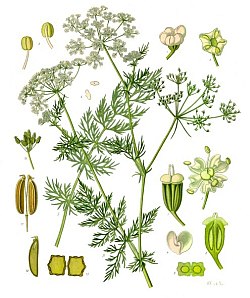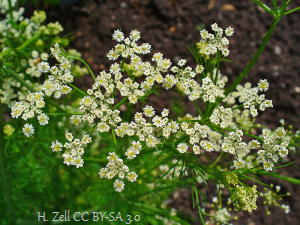Caraway Characteristics
(Carum carui, Linn.)

Name Origin:
Both the popular and botanical names are believed to be derived from Caria, in Asia Minor, where caraway appears to have first been used. More on the History of Caraway.
Natural Order:
Umbelliferæ
Growing Cycle:
Biennial or Annual Herb
Origins:
The plant seems to be a native of Europe with archeological finds in lake habitations of Switzerland.
Height:
18 – 30 inches tall
Appearance:
The fleshy yellow roots have a white meat that has a slight carroty taste.
Caraway Flowers:
Little white flowers which appear on branching stems on umbels.
Caraway Growing
(Seeds, sowing, and harvesting)
Growing Caraway From Seeds
 The seeds we know as caraway are actually brown aromatic fruits. They retain their germinating power for up to three years, and 10,000 seeds make up an ounce.
The seeds we know as caraway are actually brown aromatic fruits. They retain their germinating power for up to three years, and 10,000 seeds make up an ounce.
When growing caraway from seed, it is common to sow caraway seeds in the same drills as coriander during May or early June. The coriander matures faster and can be harvested before the caraway throws up a flowering stem.
Caraway is a biennial plant which means that it only blooms after the second year and then dies. It reseeds easily and can grow to be invasive if left unattended. Seeds can be sown in the fall which may cause the caraway plant to bloom during the first growing season.
Don’t miss our Caraway Companion Planting Guide to explore companion planting with caraway.
Culinary Uses of Caraway
(leaves and young shoots, roots, seeds and oil)
Leaves and young shoots.
Eaten cooked or as salad greens.
Roots.
Roots were commonly eaten like parsnips; but the larger size of parsnips made caraway roots less optimal for a food source.
Caraway Seeds.
Seeds are used to season breads, cheeses, liquors, salads, sauces, soups, candy, seed cakes, cookies and comfits.
Caraway Oil.
Having the characteristic flavor and odor of the fruit, caraway oil is often used in the manufacture of toilet articles such as perfumes and soaps.